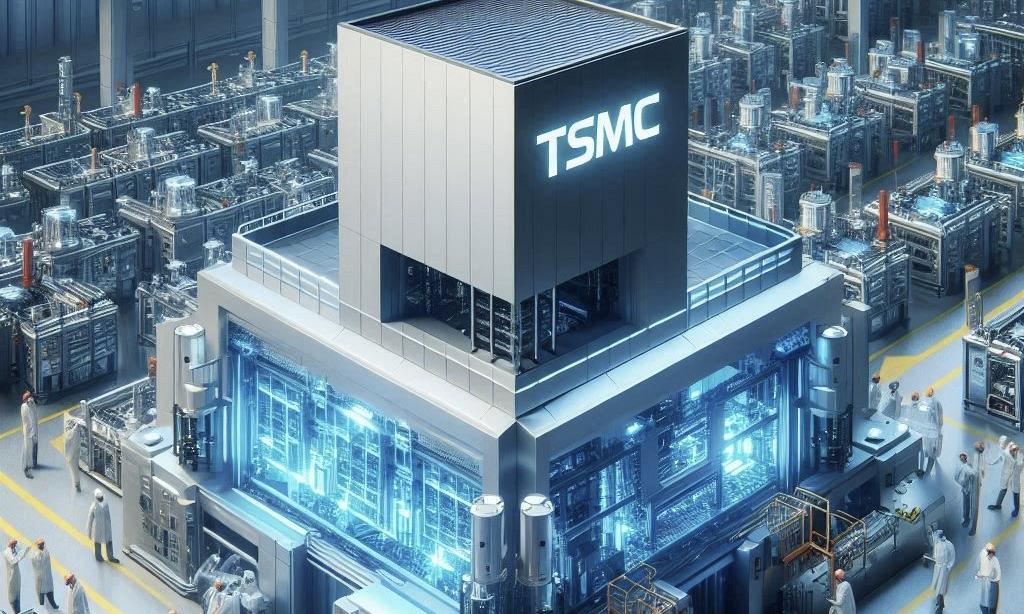TSMC is set to receive its first high NA EUV machine from ASML later this month, bolstering its competitive edge over rivals like Samsung. The advanced scanner, priced at over €400 million, will enhance TSMC’s ability to develop cutting-edge semiconductors.
TSMC Overcomes High NA EUV Cost Concerns, Set to Receive €400M Scanner for Advanced Chipmaking
Rumors are circulating in Taiwan that the Taiwan Semiconductor Fabrication Company (TSMC) is scheduled to receive its first high NA EUV chip fabrication machine from the Dutch company ASML later this month, per Wccftech.
TSMC has been embroiled in a controversy regarding high NA machines. Initially, the company's management expressed dissatisfaction with the equipment's cost earlier this year. Subsequently, the company acquired a scanner from ASML.
Compared to their EUV predecessors, the utilization of distinct lenses enables these machines to achieve a more precise resolution of smaller circuits, thereby facilitating chip manufacturers' development of cutting-edge semiconductors. According to the specifics, TSMC's high NA EUV scanner is priced at over €400 million and may necessitate traffic planning to transport it to the company's facilities.
TSMC to Maintain Edge Over Samsung with Arrival of High NA EUV Scanner, Boosting Chip Production
According to Taiwanese industry sources, TSMC will preserve its competitive advantage over its primary contract chip manufacturing rival, Samsung, after receiving its first high NA EUV scanner later this month. Using this business model, TSMC and Samsung are the sole companies worldwide producing cutting-edge semiconductors. The Taiwanese company maintains a significant market share due to its consistent product yields and robust industry partnerships.
According to the sources, the foundry allegedly spent over €200 million on TSMC's high NA EUV machine. The scanner's dimensions also pose a challenge, as specific components exceed the height of the chambers in TSMC's facilities, rendering it impossible to disassemble. They further stated that the high NA scanner is expected to be transported to TSMC's facilities at night to prevent traffic congestion and the potential implementation of unique route management plans upon its arrival in Taiwan.
Furthermore, it is anticipated that TSMC will relocate the machine to its research and development facilities to facilitate the development of advanced process technologies. The company has previously stated that the machines may not be necessary for several years, as the current iteration of EUV scanners can produce chips until at least 2026. This assertion was made about high NA EUV. TSMC intends to manufacture its A16 process technology by that time, equivalent to 1.6 nanometers in layperson's terms.
TSMC and ASML Remain Silent on High NA Scanner, as Intel and Samsung Prepare for Adoption
ASML and TSMC declined to disclose any information regarding the scanner allegedly scheduled to arrive in Taiwan later this month. Intel, which is presently grappling with exorbitant expenses, established itself as the pioneer in high-NA equipment by receiving its initial machine late last year and operating it for the first time earlier this year. The company announced in April that it intends to implement the devices into production next year to reclaim its position as a process leader.
It is rumored that Samsung, TSMC's primary contract chip manufacturing rival, will acquire the first high NA EUV detector in either Q4 2024 or 2025. Although high NA EUV devices have challenges, such as necessitating chip manufacturers to "stitch" together half fields, they also enhance productivity and throughput. By procuring them in advance, semiconductor manufacturers can resolve the technological intricacies before risking mass production or finalizing production timelines with the equipment.



 Apple App Store Injunction Largely Upheld as Appeals Court Rules on Epic Games Case
Apple App Store Injunction Largely Upheld as Appeals Court Rules on Epic Games Case  Air Force One Delivery Delayed to 2028 as Boeing Faces Rising Costs
Air Force One Delivery Delayed to 2028 as Boeing Faces Rising Costs  SpaceX Begins IPO Preparations as Wall Street Banks Line Up for Advisory Roles
SpaceX Begins IPO Preparations as Wall Street Banks Line Up for Advisory Roles  Strategy Retains Nasdaq 100 Spot Amid Growing Scrutiny of Bitcoin Treasury Model
Strategy Retains Nasdaq 100 Spot Amid Growing Scrutiny of Bitcoin Treasury Model  Australia’s Under-16 Social Media Ban Sparks Global Debate and Early Challenges
Australia’s Under-16 Social Media Ban Sparks Global Debate and Early Challenges  Intel’s Testing of China-Linked Chipmaking Tools Raises U.S. National Security Concerns
Intel’s Testing of China-Linked Chipmaking Tools Raises U.S. National Security Concerns  Mizuho Raises Broadcom Price Target to $450 on Surging AI Chip Demand
Mizuho Raises Broadcom Price Target to $450 on Surging AI Chip Demand  Nvidia Weighs Expanding H200 AI Chip Production as China Demand Surges
Nvidia Weighs Expanding H200 AI Chip Production as China Demand Surges  Woolworths Faces Fresh Class Action Over Alleged Underpayments, Shares Slide
Woolworths Faces Fresh Class Action Over Alleged Underpayments, Shares Slide  SK Hynix Shares Surge on Hopes for Upcoming ADR Issuance
SK Hynix Shares Surge on Hopes for Upcoming ADR Issuance  JD.com Pledges 22 Billion Yuan Housing Support for Couriers as China’s Instant Retail Competition Heats Up
JD.com Pledges 22 Billion Yuan Housing Support for Couriers as China’s Instant Retail Competition Heats Up  SpaceX Insider Share Sale Values Company Near $800 Billion Amid IPO Speculation
SpaceX Insider Share Sale Values Company Near $800 Billion Amid IPO Speculation  Trump Criticizes EU’s €120 Million Fine on Elon Musk’s X Platform
Trump Criticizes EU’s €120 Million Fine on Elon Musk’s X Platform  United Airlines Flight to Tokyo Returns to Dulles After Engine Failure During Takeoff
United Airlines Flight to Tokyo Returns to Dulles After Engine Failure During Takeoff  HSBC’s $13.6 Billion Take-Private Offer for Hang Seng Bank Gains Board Backing
HSBC’s $13.6 Billion Take-Private Offer for Hang Seng Bank Gains Board Backing  U.S. Greenlights Nvidia H200 Chip Exports to China With 25% Fee
U.S. Greenlights Nvidia H200 Chip Exports to China With 25% Fee  Trello Outage Disrupts Users as Access Issues Hit Atlassian’s Work Management Platform
Trello Outage Disrupts Users as Access Issues Hit Atlassian’s Work Management Platform 































